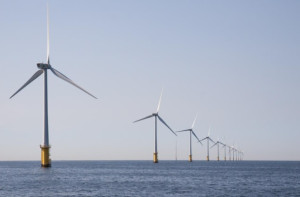Powering the Future: The Potential of Renewable Marine Energy

Posted on Mar 27, 2024 at 10:03 PM
In a world thirsty for sustainable energy solutions, the bountiful and magical realm of renewable marine energy emerges as a beacon of hope. Like a symphony of nature's might, various renewable sources come together to offer a greener and cleaner future for all.
What is Renewable Marine Energy?
Renewable marine energy is the generation of electricity through the natural movements and thermal features of the ocean and the sea. While fossil fuels are limited, marine energy resources are virtually present in the oceans and are not controlled by any season of the year.
Through the use of these renewable sources, we have the potential to decrease our dependence on limited non-renewable sources and lower the emission of greenhouse gases.
What are Renewable marine energy sources?
Marine renewable energy is much like a perpetually flowing well, the ever-generous mother nature refills it at a faster rate than we can use it.
Unlike fossil fuels like coal, oil, and gas which take millions of years to become nature’s energy and emit harmful greenhouse gases that contribute to global warming when burned, renewable energy sources provide a clear and better solution. These types of ocean energy include:
Wave Energy
Wave energy is a great source of renewables because it's produced from the rapid motion of waves which are abundant, clean, and never-ending. Wave energy converters are devices located in seas that harness the kinetic energy from waves and convert it into power through different technologies like oscillating water columns, point absorbers, and attenuators.
Tidal Energy
Tidal power is generated as a result of the gravitational pull of the moon and the sun, which creates high and low tides. Tidal power plants employ turbines that are submerged in places of tidal streams or estuaries, where the power of moving water can be harnessed and converted into electricity.
Ocean Thermal Energy Conversion (OTEC)
OTEC technology utilizes the temperature gradients that exist between warm surface water and the cold deep-water ocean. By doing so, this temperature gradient can then generate electricity based on a heat exchanger and turbine arrangement.
Salinity Gradient Energy
Differentially, salinity gradient energy also known as osmotic power, is the energy obtained from the concentration of salt in seawater and freshwater. Salt gradient produces a difference in concentration which can be used to create an electric current by employing membranes that magnetize ions allowing them to pass through.
Underwater Turbines
Submergence generators, more precisely marine current turbines, use the power of the ocean currents to transform their kinetic energy into electrical ones. The principles of these devices are identical to those of wind turbines; however, they are specially designed for underwater environments.
In addition to these resources of renewable marine energy, we're also able to produce clean electricity through traditional systems including solar panels and wind energy generators, especially in coastal areas where these devices can easily be installed or left floating near the coast, of course these resources will require a good amount of marine engineering education to work, just the same though, it will be of great benefits.

Why should we be generating renewable marine energy?
Rumour has it, that renewable energy is more expensive, less reliable, and needs more maintenance, that's why it's been an untapped field of innovation. However, valuable news and research have revealed a substantial change in facts. Turns out, renewable energy is exactly all these things, and here's why we should be using it:
-
Abundant and Renewable Resource: The oceans cover more than 70% of the Earth's surface, which makes them a virtually inexhaustible source of energy that crosses the largest expanse on the planet. The movement of waves, tides, and ocean currents is the result of natural forces that are never-ending, giving a continuous supply of renewable energy.
-
Clean and Environmentally Friendly: Renewable marine energy sources, in general, lead to minimal greenhouse gas emissions when compared to fossil fuel energy production. By implementing marine energies, we can greatly decrease the emission of greenhouse gasses and tackle climate change. It is strong not only for improving the environment, but also for raising air quality, diminishing carbon footprints, and maintaining of ecosystem.
-
Predictable and Reliable: The energy power of ocean sources like waves and tides can be forecasted and predicted with precision. In contrast to other intermittent renewable sources such as solar and wind, marine energy is characterized by unwavering and predictable power production, making it easier to put it on the electrical grid and address energy needs.
The potential of renewable marine energy
Renewable marine energy exhibits a huge capacity to become the energy industry of the future. With technological improvements and reduced cost, offshore marine energy has an ever-renewing potential to become a significant component of the worldwide energy mix. Similarly, countries with a coast or the ability to access oceans have a chance to use this clean energy source as a diversification of their power generation mix to reach ambitious sets of goals on renewable energy.
However, the transition into this future can only be effective if it's done as a collaborative effort, that's why everyone must take part.
At last
Renewable marine energy, thus, is the center light of the hope that we see while moving towards a cleaner and greener energy future. Through the development of the ocean, we can grab a vast array of renewable resources that power our households and businesses will also ensure we leave our planet healthy for future generations.
The waves of change are around and renewable ocean energy is the vessel moving us in this revolutionary process.





